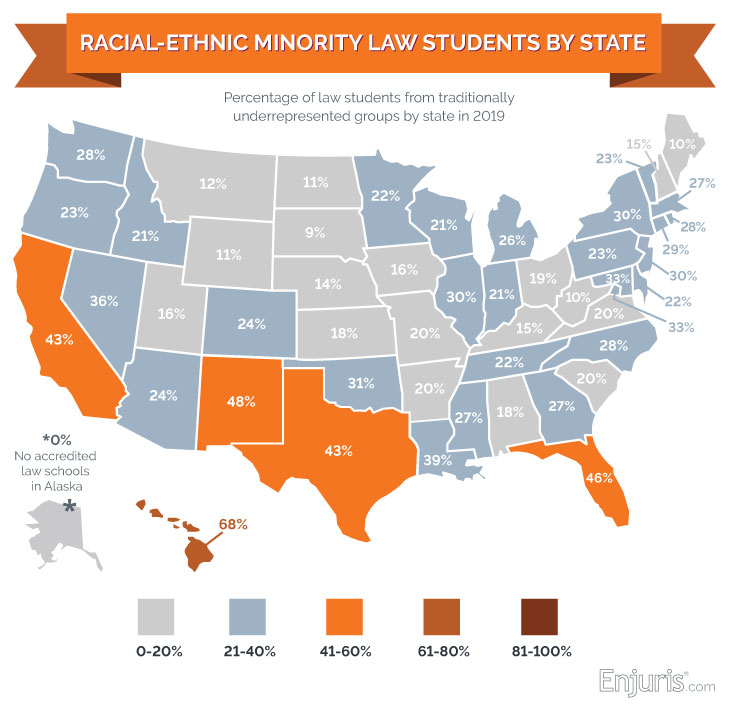
A comprehensive review of law school enrollment by race and ethnicity in 2019, with a focus on Black enrollment
According to the most recent data collected by the American Bar Association (ABA) on law school admissions, enrollment among students of color slowed in 2019.
Though enrollment numbers are similar to the previous year (historically underrepresented students made up 31.01% of the incoming 2019 class, compared to 31.21% in 2018), new data reveals that Black enrollment in law school dropped for the fourth consecutive year, underscoring the fact that even among people of color, Black students are consistently and dramatically underrepresented in law school classrooms.
Our annual Women in Law School report is updated each year to analyze enrollment law schools by gender. We also examine race and ethnicity demographics in ABA-accredited law schools to see how programs around the country rank.
The case for law school diversity
Research shows that racial, ethnic and cultural diversity in law school classrooms leads to better questions, analysis, and solutions, which translates to more just and intelligent lawyers.
What's more, racial diversity among attorneys creates greater trust in the rule of law. As Judge Edward M. Chen, the first Asian American appointed to the United States District Court for the Northern District of California, observed:
The case for diversity is especially compelling for the judiciary. It's the business of the courts to dispense justice fairly and administer the laws equally. It's the branch of government ultimately charged with safeguarding constitutional rights, particularly protecting the rights of vulnerable and disadvantaged minorities against encroachment by the majority.
How can the public have confidence in such an institution if the communities it's supposed to protect are excluded from its ranks?
Race and ethnicity classifications
The ABA requires each accredited law school to report enrollment data annually by completing a Standard 509 Disclosure. The Standard 509 Disclosure allows schools to report the race and ethnicity of their students using 7 distinct categories defined by the ABA as follows:
- Hispanics of any race: A person of Cuban, Mexican, Puerto Rican, South or Central American or other Spanish culture or origin, regardless of race.
- American Indian or Alaska Native: A person having origins in any of the original peoples of North America and who maintains cultural identification through tribal affiliation or community recognition.
- Asian: A person having origins in any of the original peoples of the Far East, Southeast Asia, or the Indian Subcontinent, including, for example, Cambodia, China, India, Japan, Korea, Malaysia, Pakistan, the Philippine Islands, Thailand, and Vietnam.
- Black or African American: A person having origins in any of the black racial groups of Africa.
- Native Hawaiian or Other Pacific Islander: A person having origins in any of the original peoples of Hawaii, Guam, Samoa, or other Pacific Islands.
- Two or more races: The category used to report a non-Hispanic person who selects two or more of the other racial categories.
- White: A person having origins in any of the original peoples of Europe, the Middle East, or North Africa.
Racial and ethnic minority representation in law schools
On average, the 2019 law school class was less racially diverse than the 2018 class.
The only race and ethnicity that increased were Asian and Hispanic/Latino students. All other races and ethnicities that the ABA tracks through the ABA Annual Questionnaire decreased slightly.
Black students represented the largest decrease. In 2018, Black students made up 7.91% of total incoming law students, but in 2019, they accounted for 7.57% of incoming law students. This drop caused the overall percentage of Black students in law school to decrease from 8.11% to 7.94%.
Tweet this
The racial and ethnic makeup of law students in ABA-accredited law schools comes close to reflecting the racial and ethnic makeup of the United States population as a whole. The first pie chart below shows the total percentage breakdown of ethnicities and races in the U.S. according to the 2010 U.S. Census.
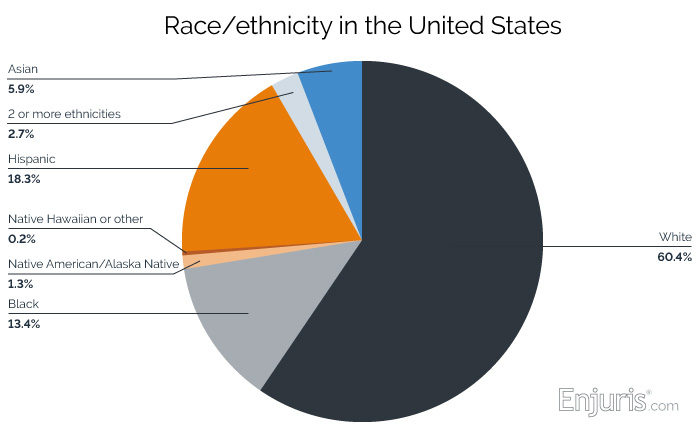
In comparison, this second pie chart shows the total percentage breakdown of ethnicities and races in all ABA-accredited law schools.
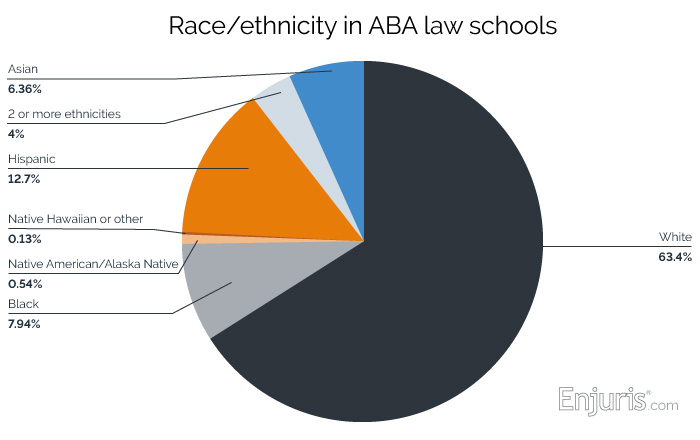
As you can see, the largest disparity between the general population and the rate of law students by race and ethnicity is law students identifying as Black, followed by law students who identify as Hispanic/Latino.
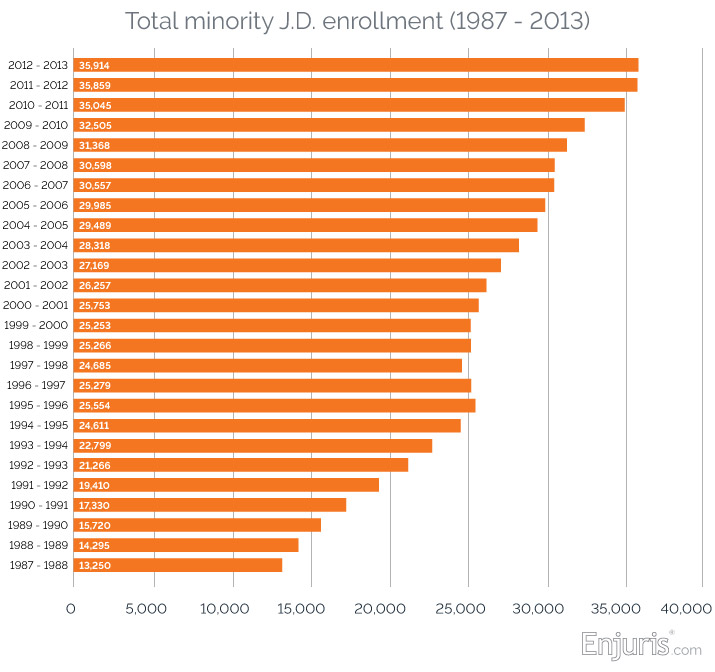
Law school rankings based on ethnic-racial minority enrollment
The ABA Council for Diversity in the Educational Pipeline and the Law School Admissions Council (LSAC) have made efforts to increase enrollment of traditionally underrepresented groups and people of color in colleges and law schools across the country.
In addition, many law schools across the country have risen to the challenge by taking steps intended to increase enrollment of Black, Latino and Indigenous Peoples in competitive law programs.
For example, Syracuse University College of Law hopes to double Black student enrollment within the next 5 years. They recently entered into "3+3 admissions" agreements with 3 historically Black colleges and universities (HBCUs) in Georgia. The 3+3 program allows students to finish a bachelor's degree and a law degree in 6 years, rather than 7.
These efforts have paid off for some schools. Below are the top 10 law schools with the highest percentage of students identifying with each race and ethnicity recognized by the ABA.
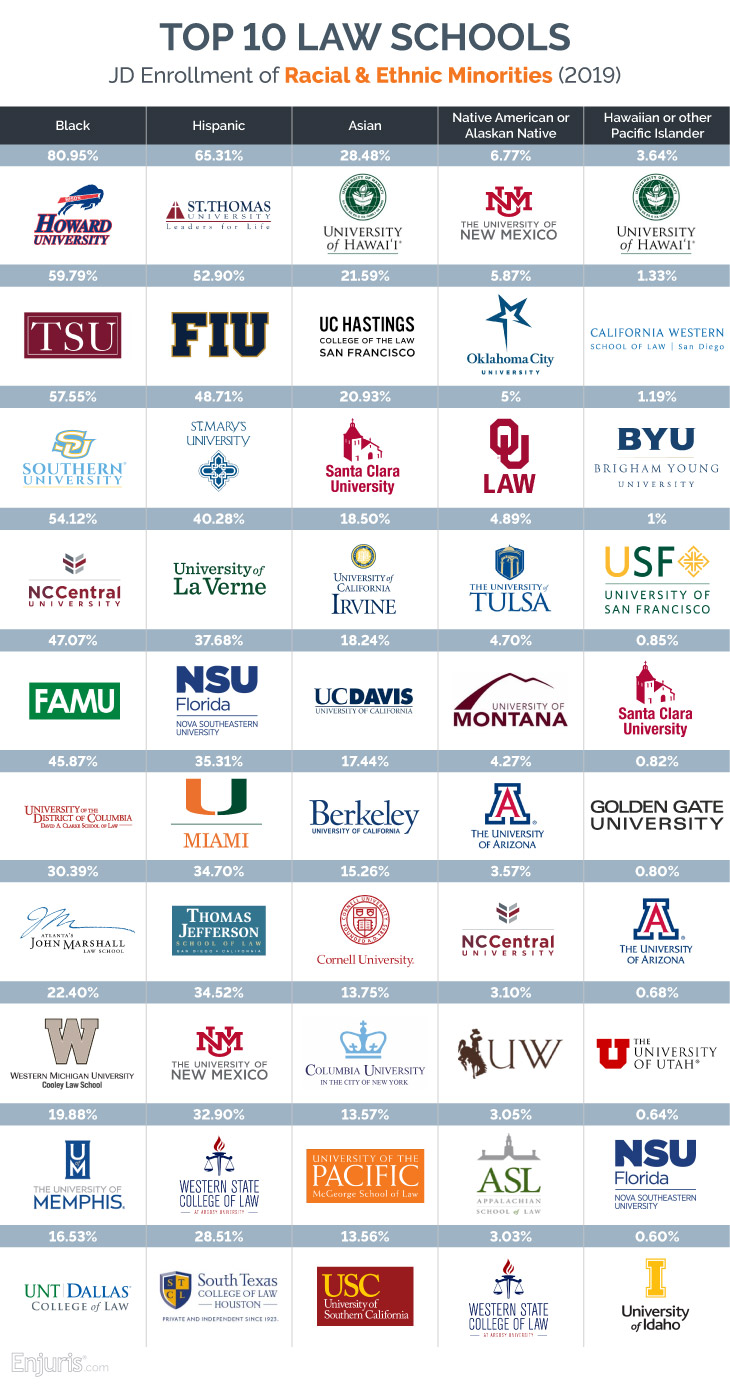
Here's a look at where students from historically underrepresented communities are not attending law school.
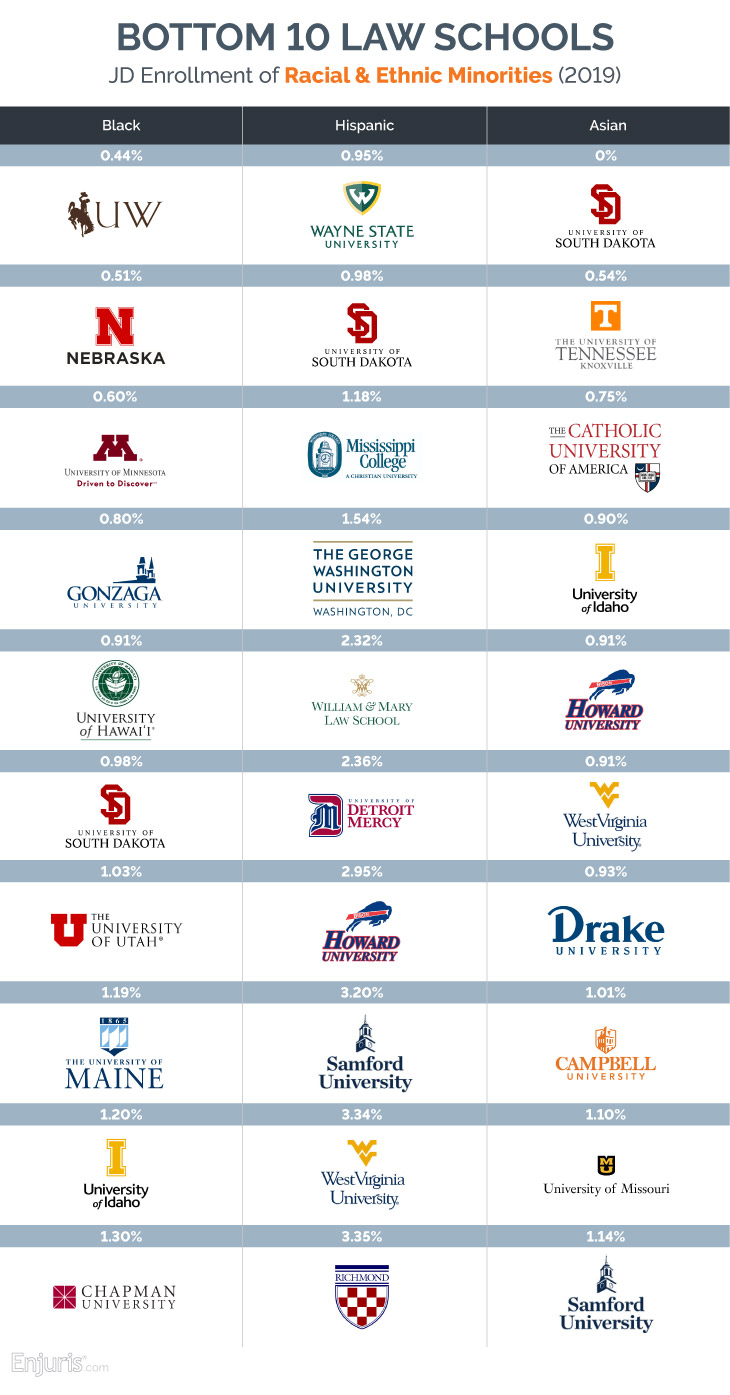
Note that the chart above doesn't include a list of schools with the lowest percentages of Native American or Alaskan Native law students. This is because there were a total of 53 ABA-accredited law schools in the U.S. that reported enrolling 0% of students who identified themselves in this group.
The chart also excludes schools with the lowest percentages of Hawaiian or other Pacific Islander law students because there were a total of 122 schools in the U.S. that reported enrolling 0% of students who identified themselves in this group.
Why are Black students underrepresented in law schools?
More so than other students of color, the number of Black students in law school does not proportionally reflect the number of Black Americans in the general population. What's more, while other historically underrepresented groups are making gains, the number of Black students enrolling in law school is actually decreasing.
The underlying reasons for this trend are complex and certainly deserve more research, but there are 3 prevailing theories.
First, a person usually can't attend law school without first graduating from college. Black students are still greatly underrepresented in undergraduate programs across the country, particularly in top colleges.
Second, Black students tend to score lower on the Law School Admissions Test (LSAT) than White students. This creates both academic barriers to law school and financial obstacles, as law schools tend to award financial aid based on LSAT scores.
Third, even though people of color generally enroll in law school in rates that closely reflect the general population, there is a large disparity in the attrition rates between White students and students of color (particularly among Blacks). For example, in 2016, White students comprised 62% of first-year law students and 49% of first-year attrition. In contrast, students of color made up only 30% of first-year enrollment but accounted for 44% of attrition.
How can students of color be more represented in American law schools?
In 2018, law schools saw a significant bump in female enrollees. Many legal commentators referred to this bump as the "Trump Bump," the theory being that the state of national politics inspired more women to attend law school.
There is hope among some experts that a similar bump might occur among Black students.
According to Dean Anna M. Han at Santa Clara University School of Law:
As a law school, we talk about diversity and inclusion, and we are proud of our achievements, but that's not enough. We need to do more and we have the tools as legal educators, lawyers, and law students. We teach social justice but must recognize that the system is not always just. We must commit to change it.
Here at Enjuris, we don't have all the answers, but it's our hope that this research serves as a foundation for the important discussions that need to take place. In the meantime, here are several resources available to Black law students and educators:
- ABA Diversity and Inclusion Center
- National Pipeline Diversity Initiatives Directory
- Directory of Diverse Speakers and Authors
- National Black Law Students Association
- The Minority Corporate Counsel Association
- Practicing Attorneys for Law Students Program
- US News 7 Tips for Applying to Law School as a Minority Applicant
To gain even more insight into law student demographics in the United States, check out our report on Women in Law School.
About Enjuris®
Enjuris.com is a collection of independent legal resources designed to help people with their biggest questions following an accident or injury. Through instructive articles written by experienced attorneys, printable forms, and a free legal directory, Enjuris provides injury victims with the information and tools they need to take the next step. In keeping with its mission, Enjuris.com also provides promising college and law school students with scholarships and other resources to help them one day become effective lawyers.
Data source: American Bar Association, ABA Required Disclosures (Standard 509 Reports). Any mistakes in data reported to the ABA are the responsibility of the reporting school. Enjuris assumes no responsibility for inaccuracies or for changes in such information that may occur after publication. The figures here are as reported on December 16, 2018. Schools may update their data at any time. Please see the ABA website for updated figures.
See our guide Choosing a personal injury attorney.
